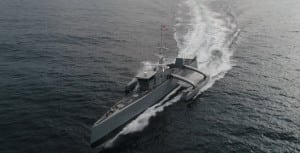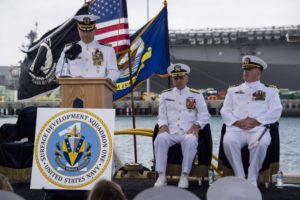Last month, the Navy transferred the Sea Hunter unmanned surface vessel from the Office of Naval Research (ONR) to Surface Development Squadron One (SURFDEVRON One).
A memorandum of agreement (MoA) signed by ONR, the Director of Surface Warfare (OPNAV N96), SURFDEVRON One, and Unmanned Maritime Systems Program Office (PMS-406) within program Executive Office Unmanned and Small Combatants (PEO USC) agreed on how to describe the relationships and responsibilities among them for the transition of the vessel.

The MoA was inked and made effective in October, with provisions to transfer responsibilities for Sea Hunter-1 upon signing the FY 2020 defense authorization act and defense appropriations bills into law or Jan. 1, whichever came first. The defense bills were signed into law in December.
ONR originally developed Sea Hunter as a medium displacement unmanned surface vehicle (MDUSV) as an Innovative Naval Prototype program to test capabilities and systems.
The memo underscored MUSVs are a “key component of the Navy’s Future Surface Combatant Force plan and OPNAV N96’s Surface Capability Evolution Plan (SCEP). The U.S. Navy will continue to integrate unmanned systems into the force to sustain its advantage in the surface domain. MDUSVs, like the Sea Hunter-1, are just one type of MUSVs that the U.S. Navy will use to sustain that advantage.”
The MoA focuses on defining areas of responsibility for efforts to transition program management of Sea Hunter-1 to PMS-406 with administrative oversight at SURFDEVRON One.
The Navy established SURFDEVRON One in May to focus on experimenting with new surface warfare capabilities for unmanned vessels and to man, train, and equip Zumwalt-class destroyers (Defense Daily, May 24, 2019).
By moving Sea Hunter, the agreement said the vessel will help develop tactics and concepts of operations for unmanned vessels.
“Sea Hunter-1 will serve as a development, training, and testing platfrom to provide information to the Navy’s MUSV program, including the development of Tactics, Techniques, and Procedures (TTPs), and Concept of Operations (CONOPs),” the MoA said.
It added transferring Sea Hunter will provide an opportunity for the fleet “to provide lessons learned to the Navy’s Unmanned Surface Vehicle (USV) programs (both medoium and large), while providing ONR Code 331 with an asset to continue MDUSV Technology Development to deliver mission-relevant autonomous capabilities.”
This is in line with a December direction from Fleet Forces Command for the Commander of Naval Surface Forces U.S. Pacific to have SURFDEVRON One develop the concepts of operations for Medium and Large Unmanned Surface Vessel programs (Defense Daily, Jan. 3).
Under this MoA, PMS-406 accepts custody of Sea Hunter and assumes responsibilities as the program manager to include test plan approval, maintenance and sustainment, and supporting SURFDEVRON One.
It also assumes responsibility for configuration management of the vessel, funding planned testing to offset maintenance and sustainment costs incurred by ONR occurring in the first quarter of FY 2020, coordinating support infrastructure at naval facilities to support Sea Hunter maintenance and sustainment, and funding and executing all existing Sea Hunter-1 maintenance and sustainment contracts.
SURFDEVRON One assumes administrative and operational control of Sea Hunter-1 and its associated control stations. It will also maintain the master experimentation and operational schedule for the vessel; establish policy and procedures for scheduling; provide personnel to train in operations/maintenance/sustainment; and develop a training and certification program to qualify Sea Hunter-1 operators in collaboration with PMS-406 and ONR.

The squadron will also “maintain final approval authority” for exercises and development testing with the vessel, to authorize Sea Hunter-1 to get underway for any event and on all non-ONR funded test plans.
ONR is not completely divesting itself from Sea Hunter under this transfer. The office will not only provide the vessel, temporary and ashore operator control stations and trains SURFDEVRON One personnel on how to operate/maintain/sustain it, but also conducts and funds technology development in numerous areas.
This includes advanced radar processor and environmentally adaptive radar perception for operator trust; stereo-optical/infrared (EO/IR) perception for emission control operations; EO/IR pan/tilt/zoom for operator trust and intelligence, surveillance and reconnaissance; multi-MDUSV situational awareness; modeling and simulation; reliability analysis; at-sea testing supporting ONR technology development, converting a surrogate vessel to Sea Hunter autonomous control; and working on payloads like a towed sonar array and unmanned aerial vehicles.
The MoA specifically said ONR will manage, fund and execute existing contracts with Leidos [LDOS] for Sea Hunter-1 technology development: design, contruction and testing of Sea Hunter-1 ending December 2019; Sea Hunter-1 construction and autonomy technology development ending December 2020; and MDUSV technology development ending March 2021.
OPNAV N96 agreed to coordinate with PMS-406 “to ensure out-years funding is properly programmed for operations, maintenance and sustainment for Sea Hunter-1.”
This is required because an early transition off Sea Hunter from ONR to SURFEVRON caused a shortfall in FY 2020 fleet exercises. A March 2019 USV Executive Steering Group meeting agreed FY 2020 exercises “would require funding assistance form Fleet sources.”
The parties agreed to attend periodic working group and Council of Captain meetings to help coordinate the roles and responsibilities in the documents. Working groups will address technical and schedule issues while the council will allow program level coordination to resolve issues “and ensure alignment with objectives of this MoA.”
The agreement is set to expire in September 2025, when the MOA is canceled, or is superseded by another agreement, whichever is first.